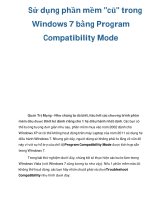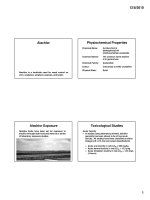risk perception dec 15 compatibility mode
Bạn đang xem bản rút gọn của tài liệu. Xem và tải ngay bản đầy đủ của tài liệu tại đây (85.37 KB, 5 trang )
1
RISK PERCEPTIONRISK PERCEPTION
Len Ritter
Maged Younes (WHO)
PROCESS OF RISK PROCESS OF RISK
PERCEPTIONPERCEPTION
aIntuitive judgement process
aExperience with hazards come from
news media. Associated with
mishaps and global threats
aCognitive frame: concept of
chemicals as pollutants and poisons
aOutrage factor
COMPARING RISKSCOMPARING RISKS
aIf the risk of dying from being struck by
lightening is 1, relative risk values for
certain factors would be:
a
Death in air traffic
2
a
Death
in
air
traffic
2
a Meteorite: 7
a AIDS 24
a Home accidents 182
a Traffic accidents 286
a Alcohol 645
a Pulmonary cancer 870
a All cancers 5263
a Cigarette smoking 6060
RISKS THAT INCREASE PROBABILITY RISKS THAT INCREASE PROBABILITY
OF DEATH BY ONE IN A MILLIONOF DEATH BY ONE IN A MILLION
a Smoking 1.4 cigarettes (Cancer/heart disease)
a Travelling 10 miles by bicycle (Accident)
a Travelling 300 mile by car (Accident)
a
Flying
1000
milesbyjet (Accident)
a
Flying
1000
miles
by
jet
(Accident)
a One chest X-ray (Cancer from radiation)
a Living 150 years within 20 miles of a nuclear
power plant (Cancer from radiation)
a Risk of accident by living within 5 miles of a
nuclear reactor for 50 years (Cancer from
radiation)
2
Mosaic of public perceptions of risks in terms of risk assessment quadrantsMosaic of public perceptions of risks in terms of risk assessment quadrants
UNDERESTIMATED RISKSUNDERESTIMATED RISKS
aSmoking
aAlcohol consumption
a
Risky sporting activities
a
Risky
sporting
activities
aMotorcar traffic
aInfectious diseases
aHeart diseases due to overweight
and lack of physical activity
OVERESTIMATED RISKSOVERESTIMATED RISKS
aAir traffic
aRadioactivity
aHazardous waste
aChemicals in food
aSnakebites
aLightning strike
FACTORS INFLUENCING FACTORS INFLUENCING
RISK PERCEPTIONRISK PERCEPTION
aLikelihood of adverse outcomes
aFamiliarity, dread and spread of
hazard
hazard
aWho is affected? Individual risk
aVoluntary or accepted risk?
aBenefits from accepting risk
3
FACTORS CAUSING FACTORS CAUSING
OUTRAGE OUTRAGE
aPotentially uncontrollable risks
a
Ability to cause catastrophe on a
a
Ability
to
cause
catastrophe
on
a
global scale
aRisk to future generations
aDreaded outcomes
FACTORS AFFECTING RISK FACTORS AFFECTING RISK
PERCEPTIONPERCEPTION
FACTOR CONDITIONS CONDITIONS FOR
FOR INCREASED DECREASED PUBLIC
PUBLIC CONCERN CONCERN
___________________________________________________
Catastrophic Effects grouped in Effects grouped in
potential time & space time & space
Familiarity Unfamiliar Familiar
Understanding Mechanisms/pro- Mechanisms/process
cess not understood understood
Pers. Controllability Uncontrollable Controllable
FACTORS AFFECTING RISK FACTORS AFFECTING RISK
PERCEPTION (PERCEPTION (22))
FACTOR CONDITIONS CONDITIONS FOR
FOR INCREASED DECREASED PUBLIC
PUBLIC CONCERN CONCERN
___________________________________________________
Voluntariness Involuntary Voluntary
Effects on children Special risk no special risk
Effect manifestation Delayed effects Immediate effects
Future generations Risk No risk
Victims Identifiable Statistical
FACTORS AFFECTING RISK FACTORS AFFECTING RISK
PERCEPTION (PERCEPTION (33))
FACTOR CONDITIONS CONDITIONS FOR
FOR INCREASED DECREASED PUBLIC
PUBLIC CONCERN CONCERN
___________________________________________________
Dread Effects dreaded Effects not dreaded
Institutions Lack of trust Institutions trusted
Media attention High Low
Accident history Accidents No accidents
Equity (Risk/ Inequitable Equitable
benefit distrib.)
4
FACTORS AFFECTING RISK FACTORS AFFECTING RISK
PERCEPTION (PERCEPTION (44))
FACTOR CONDITIONS CONDITIONS FOR
FOR INCREASED DECREASED PUBLIC
PUBLIC CONCERN CONCERN
__________________________________________________
_
Benefits Unclear benefits Clear benefits
Reversibility Effects irreversible Effects reversible
Origin Caused by human Caused by acts of
action/failure nature
RISK TOLERANCE RISK TOLERANCE
SUMMARY OF FACTORSSUMMARY OF FACTORS
FACTOR/CHARACTERISTIC DIRECTION OF INFLUENCE
___________________________________________________
1. Personal control Increases risk tolerance
2. Institutional control Depends on confidence in
institutional performance
3
Vl i
Iikl
3
.
V
o
l
untar
i
ness
I
ncreases r
i
s
k
to
l
erance
4. Familiarity Increases risk tolerance
5. Dread Decreases risk tolerance
6. Inequitable distribution of Depends on individual
risks and benefits utility, strong social
incentive for rejecting
risks
7. Artificiality of source Amplifies attention to risk, often
decreases tolerance
8. Blame Quest for sociopolitical response
CHARACTERISTICS OF RISKCHARACTERISTICS OF RISK
aa
KnowledgeKnowledge
: Society’s awareness of risk from
activity (food additives: little; alcohol: much)
aa
NewnessNewness
: Extent of societal experience (guns:
old
;
biotechnolo
gy
: new
)
;gy)
aa
VoluntarinessVoluntariness
: Extent of individual’s choice
about exposure (crime: involuntary; rock
climbing: voluntary)
aa
ControlControl
: Extent of ability of individual to control
exposure, protect himself, or control
consequences (uncontrollable risks: natural
disasters)
CHARACTERISTICS OF RISK CHARACTERISTICS OF RISK
((22))
aa
DreadnessDreadness
: Level of fear of risk or consequence
(smoking: people do not dread; dioxins: people
have great dread)
ChiilChiil
Ch f id d
aa
C
atastrop
hi
c potent
i
a
lC
atastrop
hi
c potent
i
a
l
:
Ch
ance o
f
w
id
esprea
d
disastrous outcome (vaccination: not likely;
nerve gas: likely)
aa
EquityEquity
: Equal sharing of risks and benefits
(hazardous waste dumps: distributed unequally;
water chlorination: distributed equally)
5
INTUITIVE BIASES OF RISK
PERCEPTION
a
Availability
: Events that come to mind
immediately are rated as more probable
than those less mentally available
a
Ahi fft
P b biliti
a
A
nc
h
or
i
ng e
ff
ec
ts
:
P
ro
b
a
biliti
es are
adjusted to availability or perceived
significance of information
a
Representativeness
: Singular/anecdotal
events regarded as more typical than
information based on frequencies
ROLE OF MEDIA IN SHAPING ROLE OF MEDIA IN SHAPING
RISK PERCEPTIONRISK PERCEPTION
a Mechanisms of risk perception depend upon
information (personal experience or media)
a Messages undergo a transformation process;
they may reflect reality or not
they
may
reflect
reality
or
not
a Characteristics:
`Media construct reality to suit readers’
understanding
`Media direct attention to events, not
developments
`Media have no mechanism to resolve conflicts
among experts
IMPLICATIONS FOR RISK IMPLICATIONS FOR RISK
ASSESSMENT AND ASSESSMENT AND
MANAGEMENTMANAGEMENT
aStakeholder involvement in all stages of
risk assessment
a
Addressing public concerns adequately
a
Addressing
public
concerns
adequately
aConsider risk perception issues in risk
management/risk reduction decisions
aOpenness and transparency
aDesign adequate risk communication
strategies
![chương 13 Rui ro va loi nhuan [Compatibility Mode]](https://media.store123doc.com/images/document/13/y/xh/medium_RpdpAoiSgh.jpg)
![RADIOGRAPHIC TESTING NDT – CHUP ANH PHONG XA [compatibility mode]](https://media.store123doc.com/images/document/13/to/wi/medium_wix1380936528.jpg)
![3 principles of testing [compatibility mode]](https://media.store123doc.com/images/document/14/y/sw/medium_5ptPvvn6I4.jpg)


![vnisa - check point managed services [compatibility mode]](https://media.store123doc.com/images/document/2014_10/19/medium_msg1413688436.jpg)
![các giao thức sử dụng và định tuyến trong mạng voip [compatibility mode]](https://media.store123doc.com/images/document/2015_01/09/medium_fts1420774440.jpg)


